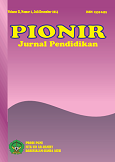DEVELOPING BEGINNING READING USING PICTURE AND PICTURE LEARNING MODEL
DOI:
https://doi.org/10.22373/pjp.v12i3.21624Abstract
The reading ability of beginner students at SD Negeri Lamklat is still low. In a reading lesson, they can name the letters of the alphabet in the reading sequence from A to Z. However, if the letters are scrambled, most students cannot remember how to pronounce the letters correctly. Apart from that, their pronunciation and intonation when reading are also inappropriate. Therefore, this research aims to determine the influence of the Picture and Picture learning model to improve the beginning reading skills of grade I students at SD Negeri Lamklat, Kabupaten Aceh Besar. The research method used is the One Group Pre-test-Post-test Design of Pre-Experiment. The sample of this study was 22 grade 1 students. An oral pre-test and post-test were used to collect the data. Completion of the initial reading ability test results is carried out using statistical tests with a significance level of 0.05 and using the percentage formula. The results of the research show that the use of pictures and pictures influences the students' ability. After testing, it is found that t-test = 4.395 and t-table = 1.721. Thus, t-test ≥ t-table or 4.395 > 1.721. Therefore, it can be concluded that the hypothesis in this research (Ha) is accepted. In addition, the average score for the pre-test was 51.363 and the post-test was 91.363. Thus, the finding shows that there is an impact of the use of the Picture and Picture learning model in developing the initial reading ability of the students.
Downloads
Published
Issue
Section
License
- Authors retain copyright and grant the journal right of first publication with the work simultaneously licensed under a Creative Commons Attribution License that allows others to share the work with an acknowledgment of the work's authorship and initial publication in this journal.
- Authors are able to enter into separate, additional contractual arrangements for the non-exclusive distribution of the journal's published version of the work (e.g., post it to an institutional repository or publish it in a book), with an acknowledgment of its initial publication in this journal.
- Authors are permitted and encouraged to post their work online (e.g., in institutional repositories or on their website) prior to and during the submission process, as it can lead to productive exchanges, as well as earlier and greater citation of published work (See The Effect of Open Access).

